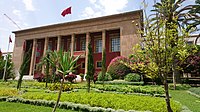National Legislative Council (Talahara)
This article is incomplete because it is pending further input from participants, or it is a work-in-progress by one author. Please comment on this article's talk page to share your input, comments and questions. Note: To contribute to this article, you may need to seek help from the author(s) of this page. |
Supreme Legislative Council ⵉⵙⴰⵡⴰⵍⴰⵡⴰⴽⵔⴰⴷ Isawalawakrad | |
|---|---|
 Lion's paw sigil | |
| Type | |
| Type | Unicameral national assembly of Talahara |
| History | |
| Founded | 1841 |
| Preceded by | Commune Council |
| Structure | |
 | |
Political groups |
|
Length of term | Four years, no term limits |
| Elections | |
| Each seat elected from a Superior Legislative Council by instant-runoff | |
First election | May 23, 1841 |
Last election | May 23, 2021 |
Next election | May 23, 2025 |
| Redistricting | Every twelve years |
| Meeting place | |
 Jama'at, Maktarim | |
 | |
The Supreme Legislative Council (Takelat: Isawalawakrad; ⵉⵙⴰⵡⴰⵍⴰⵡⴰⴽⵔⴰⴷ), often referred to as the Supreme Council, is the national legislative body of the Talaharan Commune. Aside from constitutionally-provided authority, most of the Supreme Council's authority is devolved upward from lower councils, where the scale of issues or local resources are insufficient. Key areas over which the Supreme Council has authority to legislate include aspects of education, environmental regulations, healthcare, housing, industrial regulations, legal codes, and national transportation.
The Supreme Council is a unicameral assembly and the final level of Talhara's three-tier nested council system. Members are elected from each of the 50 Superior Legislative Councils, who are respectively elected from 1,250 Local Legislative Councils. Elections to a subsequent level of government are held popularly, utilizing an instant-runoff ballot among candidates in a citizen's council region who self-nominate for the appointment.
Each of the 50 members of the Supreme Council represents approximately one million citizens. Following the Fourth Amendmendment of Part III of the Constitution of Talahara in 2008, additional seats may be added in future redistricting to allow for approximate representation of one million citizens per seat. It is expected that the 2025 redistricting process will see the Supreme Council grow from 50 to 52 or 53 seats.